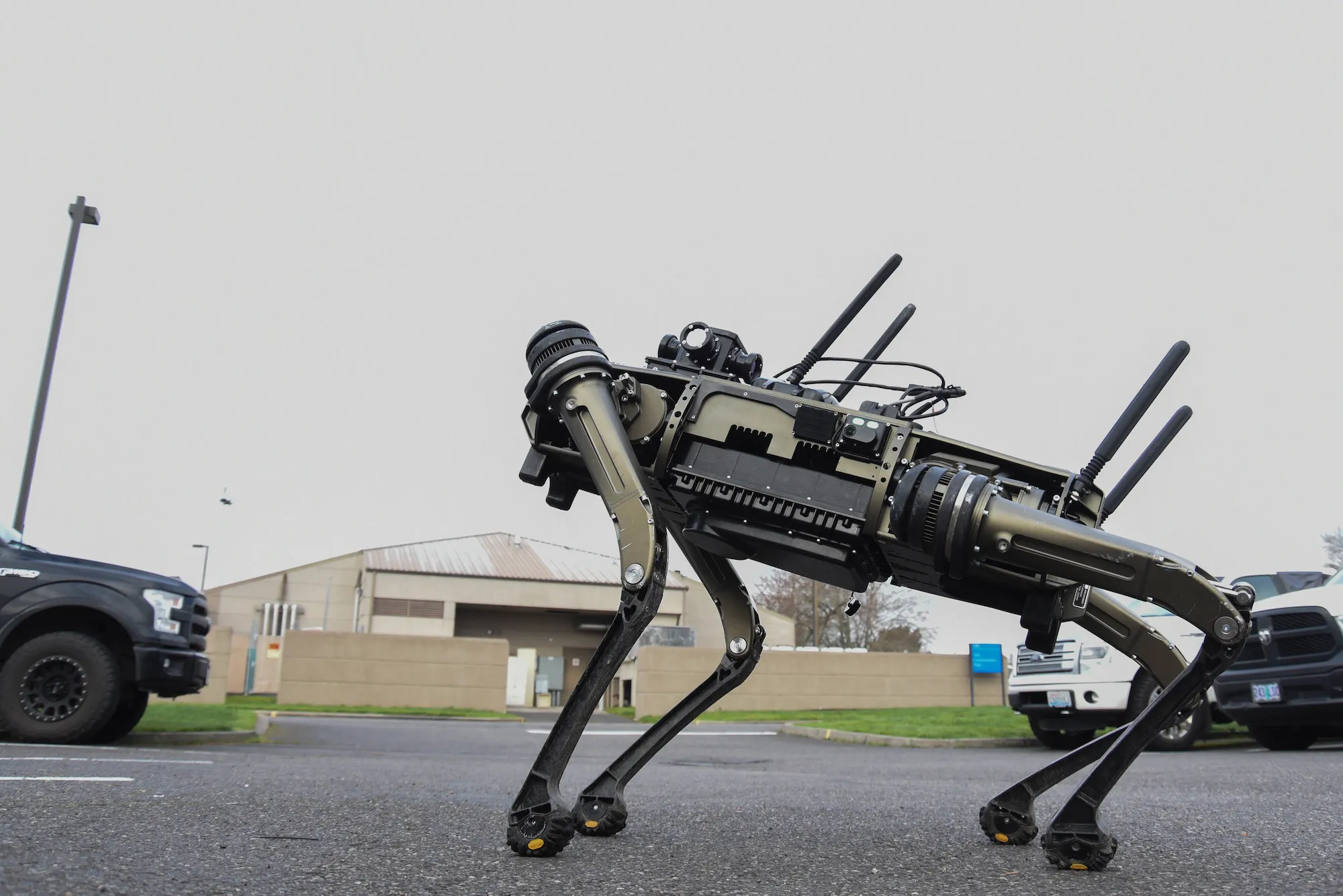

Legs folded underneath its body, a dog-shaped robot motors through a shallow stream, front-facing sensors pointing forwards above the water’s surface. Upon reaching the shore, the legs unfolded, and the robot bounds forward, its gait the now-familiar weirdness of a robot imitating a canine. Announced on social media June 13, this new amphibious adaptation is the Vision 60 Quadruped Uncrewed Ground Vehicle, or Q-UGV, from Ghost Robotics. The underwater propulsion system, made by Onyx Industries, is called the Nautical Autonomous Unmanned Tail (NAUT).
The Air Force is already using Vision 60 robots for patrols around Florida’s Tyndall Air Force Base. There, the legs let the robots march through muck and keep perimeters under surveillance without complaint. The new nautical equipment offers the possibility for port patrols, and to accompany forces in the field further, where other machines cannot go.
The Vision 60, like other animal-inspired robots, is partly a work of biomimicry—using a machine to imitate a living creature. There’s a host of reasons to do so, not the least of which is that a four-legged body is quite useful for navigating over difficult terrain alongside humans. This was the impetus between the DARPA-funded, and Boston-Dynamics-built, Legged Squad Support System, a gas-powered kit-carrying mule robot explored by the Marine Corps before it was canceled as too loud to use in war. In 2019, the Army explored an all-electric legged robot to similar ends, dubbed the Legged Locomotion and Movement Adaptation, or LLAMA.
[Related: Ghost Robotics now makes a lethal robot dog]
However, modern quadrupedal robots, like the Boston Dynamics Spot family of machines and Ghost Robots Q-UGV, run on battery power, and can move much more quietly alongside people or over walkable terrain. This is the big promise of biomimicry, and of machines that can go in places people can. Where machines excel is in taking an animal-inspired body and modifying it in a way that does not occur naturally. Famously, the Spot variants added a robotic limb with a gripper, allowing the machine to toss cans of beer and manipulate doors.
And now the NAUT allows a dog-shaped robot to move with water jet propulsion. The jet takes in water and ejects it at greater speed, allowing the Vision 60 to move with vectored thrust in a body of water.
“The system is capable of propelling the robotic dog and speeds up three knots and can operate at full power using a dedicated power source for approximately 35 minutes,” reports The War Zone. “The ‘tail’ can also continue to function after that by drawing electricity from the robot dog’s own internal power source.”
At 3 knots, or just 3.4 mph, the NAUT-powered Vision 60 won’t be winning any races, but should be perfectly capable of crossing streams and calm waters. The ability to go amphibious makes a robot useful in scouting and patrols in coastal or riverine terrain, and possibly even of use in the tricky terrain of a marsh or bayou. For soldiers and marines fighting on foot, traversing such obstacles means slowing down and leaving vehicles that cannot handle the ground behind. A robot scout could keep pace with troops, and it could also be used to find a safer crossing, without worry that it will get stuck when its legs cannot reach the riverbed.
[Related: The Air Force’s new guard dogs are robots]
Beyond the NAUT tail, Vision 60 robots can be outfitted with lidar, a tool that lets the machine map its surroundings with a laser, and even weapons, like the sniper rifle carrying version that debuted in 2021. Putting multiple modifications on the same robot may saddle its battery and motors with too much for a given mission, but the ability to swap out and add modifications means the robot can be a useful tool in a variety of circumstances.
A legged robot that can walk everywhere a human can is a useful companion. A robot that can be piloted to scout ahead, crossing a river in advance of a larger force to ensure the landing site is safe, is a more powerful asset. The greater utility of the Vision 60 will depend to some extent on how autonomously it can travel over land and through water, but even the ability to follow GPS waypoints plotted on a control pad could let the machine explore ahead, as quietly as its electric motors will allow.
Watch a longer video about the swimming machine, here.
